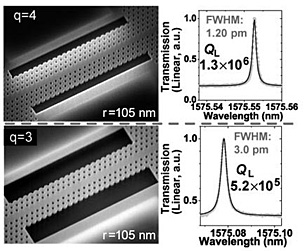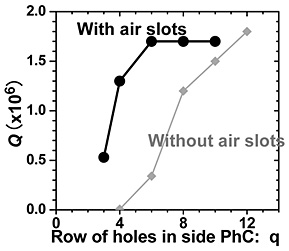Akihiko Shinya, and Masaya Notomi
Optical Science Laboratory
We have developed width-modulated photonic crystal (PhC) slab line-defect
nanocavities with an ultrahigh Q (calculation: 〜108, experiment: 〜106) [1]. The main advantage of a PhC nanocavity over other micro-cavities
is its ultrasmall mode volume, which is usually about 0.1 µm3 or less. However, conventional PhC nanocavity designs require a thick PhC barrier, which considerably increases the net cavity size. It was believed that a thick photonic bandgap barrier was needed to prevent light leaking from the nanocavity. In this study, we propose a new design scheme that uses a pair of long air slots, which act as low refractive index barriers in the side directions, instead of thick PhC barriers. Here the main role of the thin side PhC is to create a mode-gap barrier in the line defect direction. We demonstrate that the new design scheme preserves most of the performance characteristics of ultrahigh-Q nanocavities [1] even when the PhC slab barriers are very thin [2].
Figure 1 shows suitably designed nanocavities with air slots fabricated
in a Si membrane. A width modulated nanocavity is placed exactly at the
center of the narrow part. In spite of the very thin side PhC barrier (rows
of holes in side PhC: q was 3 and 4), the samples show very high Q values of 5.2×105 and 1.3×106, respectively. Figure 2 compares nanocavities with and without air slots
as a function of PhC barrier thickness. The highest Q obtained for the thick barrier sample was 1.8×106. Figure 2 clearly demonstrates that the air slots greatly improve the
Q value when the side PhC barrier is very thin. Very recently, an advanced
design realized an experimental Q of 106 at q=3 and 3.2×105 at q=2 [3]. The new cavity design greatly reduces the net size of an ultrahigh-Q PhC nanocavity. Moreover, the new cavity design is very suitable for the
study of opto-mechanics because it easily realizes a compact narrow beam
with very light weight. A possible application is a mechanical oscillator
with built-in high-Q optical nanocavity.
[1] Kuramochi et al., Appl. Phys. Lett. 88 (2006) 041112.
[2] Kuramochi et al., Appl. Phys. Lett. 93 (2008) 111112.
[3] Kuramochi et al., The 8th International Photonic & Electromagnetic Crystal Structures Meeting (PECS-VIII), Sydney, Australia (April 2009).
 |
 |
|||||
|
|